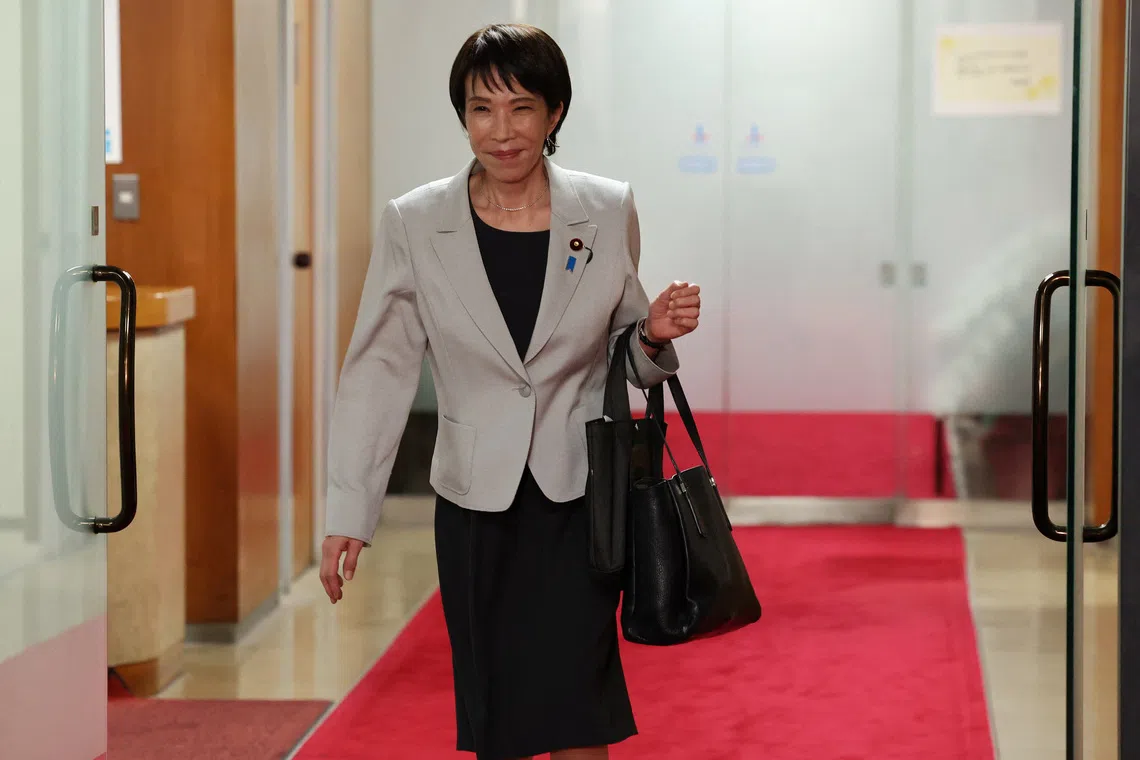News analysis
Japan’s fractured politics could ensnarl Takaichi’s economic plans
Sign up now: Get insights on Asia's fast-moving developments

Ms Sanae Takaichi, leader of Japan’s ruling Liberal Democratic Party, leaving after a meeting with party members at its headquarters in Tokyo on Oct 16.
PHOTO: REUTERS
Follow topic:
TOKYO/WASHINGTON – After a wild week, Ms Sanae Takaichi may have found the political support she needs to become Japan’s next prime minister – but the new cross-party alliances come with risks that her economic plans will get mired in an increasingly fragmented legislature.
Japan’s Lower House of Parliament is set to select a prime minister to replace Mr Shigeru Ishiba on Oct 21, and Ms Takaichi is likely to win amid a lack of any strong alternative bids.
Ms Takaichi won the race to become leader of the ruling Liberal Democratic Party (LDP)
That has forced her to seek support from other parties
On the one hand, such an alliance could give Ms Takaichi the green light to loosen the fiscal spigot through big spending and even tax cuts, given her focus on revitalising growth over restoring fiscal discipline.
But a much less cohesive political consensus and the LDP’s weakened minority government risk stalling legislation needed to address Japan’s chronic labour shortages, rapidly ageing population and acute supply constraints.
“No matter who leads, there’s a high chance of expansive economic packages being passed – as a result, they are easier for opposition parties to support,” said Daiwa Institute of Research senior economist Keiji Kanda.
“But there are other policy priorities Japan needs to push forward to deal with supply constraints, which likely won’t make much headway, given the political situation,” he added.
Beware the hawks, beware the markets
The political instability adds to uncertainty for companies scrambling for clarity on the impact of US tariffs, and could weigh on an already fragile economic recovery.
Ms Takaichi may also face constraints on the scale of spending, given her weak standing within the ruling party and the presence of veteran lawmakers with more conservative views on policy.
Among them is former premier and finance minister Taro Aso, who was appointed party vice-president. He has pushed to keep heavily indebted Japan’s fiscal house in order and avoid over-reliance on loose monetary policy to reflate growth.
Mr Noriatsu Tanji, chief bond strategist at Mizuho Securities, said: “The reflationist-minded fans of former premier Shinzo Abe’s stimulus policies have lost power within the party.
“That means Ms Takaichi must negotiate with lawmakers from other factions. It would be hard for her to go big on reflationist policies.”
Potential alliance partner Ishin has focused more on deregulation than big spending, in contrast to Ms Takaichi’s preference for government-driven industrial policy.
“If the LDP and Ishin form an alliance, it won’t immediately lead to big fiscal spending. The key policies Ishin proposes don’t require significant debt issuance,” analysts at Daiwa Securities wrote in a research note.
In the end, it may be markets that could serve as a constraint against calls for big, blanket spending. Japanese government bond yields have crept up, particularly at the long end of the curve, as markets price in the chance of more debt issuance to fund spending plans.
The rise in yields would increase the cost of servicing Japan’s huge debt pile. The Bank of Japan can no longer be relied upon to cap borrowing costs as it slowly but steadily tapers bond purchases under a pre-set programme.
The International Monetary Fund (IMF) urged Japan to avoid cutting the consumption tax rate or resorting to blanket subsidies.
“We acknowledge that there may be parts of the economy that need support, especially low-income households that are constrained and facing high food prices. But we believe any support would need to be targeted to those who need it, and be temporary,” Dr Nada Choueiri, deputy director of IMF’s Asia and Pacific Department, told Reuters in Washington on Oct 15.
“Our advice to whoever comes as a government is to put in place a consolidation plan, so that they continue to reduce the deficit.” REUTERS

